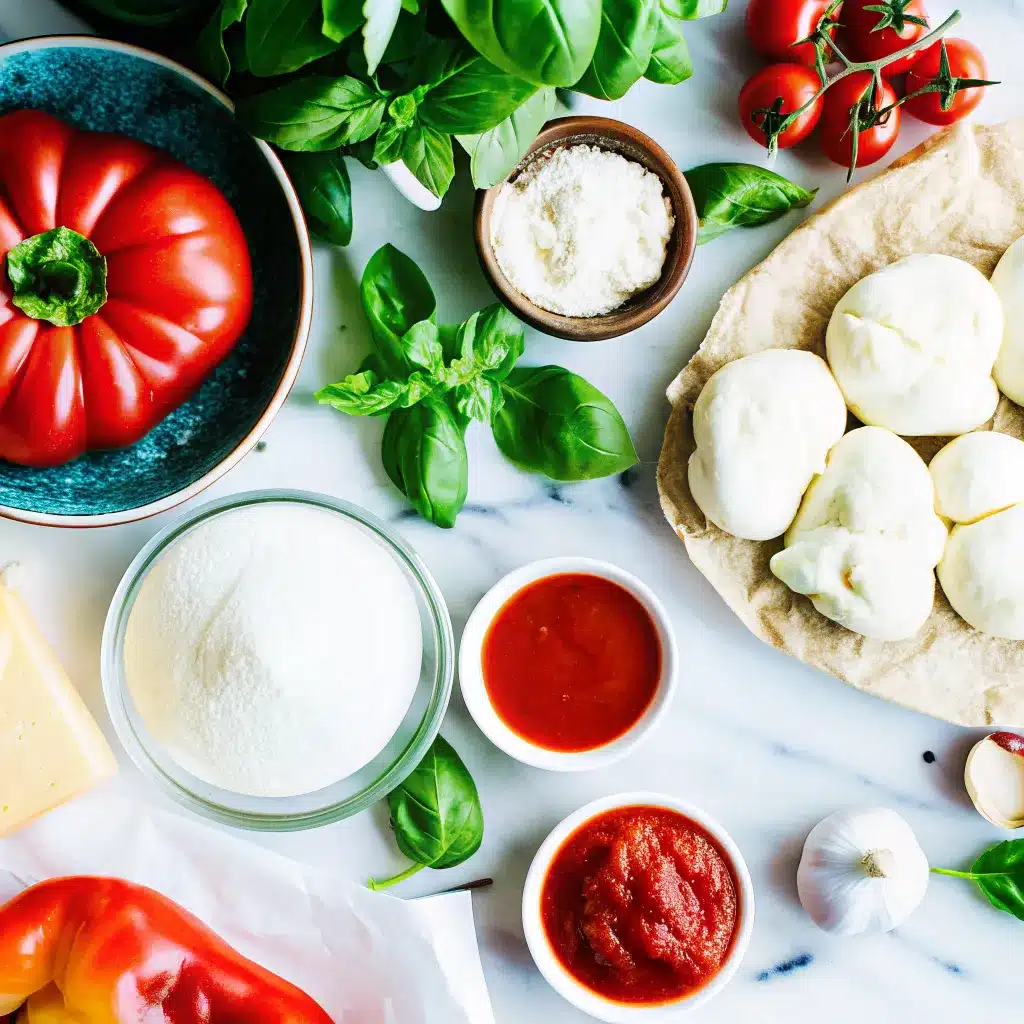Classic Margherita Pizza is more than just a meal it’s a warm slice of history that has traveled from the wood-fired ovens of Naples to kitchens around the world. With its simple yet bold trio of San Marzano tomatoes, creamy mozzarella, and fresh basil, this pizza isn’t just beautiful it’s beautifully balanced.
Growing up in my sun-kissed village on Italy’s southern coast, the Classic Margherita Pizza wasn’t something we ordered it was something we created with love, laughter, and flour-covered hands. I remember watching my Nonna gently stretch dough on the floured counter, her kitchen filled with the scent of simmering tomatoes and fresh herbs. That scent still lives in my memory and now, in my oven.
In this step-by-step guide, I’ll teach you how to recreate that magic at home no wood-fired oven required. Just a few honest ingredients, the right technique, and a sprinkle of tradition. Let’s bring Naples to your kitchen.
Print
Classic Margherita Pizza: A Timeless Recipe Straight from My Italian Roots
A classic Margherita Pizza recipe made with simple, fresh ingredients and baked to perfection in a home oven. This traditional Italian favorite features a crisp, chewy crust, creamy mozzarella, and vibrant tomato sauce.
- Total Time: 1 hour
- Yield: 2 medium pizzas 1x
Ingredients
2 ½ cups (300 g) unbleached all-purpose flour
1 teaspoon granulated sugar
½ teaspoon active dry yeast or SAF instant yeast
¾ teaspoon kosher salt
7 ounces warm water (105°F to 115°F)
1 tablespoon extra virgin olive oil
Semolina and all-purpose flour, for dusting
1 cup puréed or crushed canned San Marzano tomatoes
2–3 garlic cloves, grated or pressed
1 teaspoon extra virgin olive oil (plus more for drizzling)
2–3 pinches kosher salt, to taste
¼ teaspoon freshly ground black pepper
2–3 tablespoons finely grated Parmigiano-Reggiano cheese (plus more for serving)
7 ounces fresh mozzarella, cut into ½-inch cubes
5–6 fresh basil leaves (plus more for garnish)
Dried red pepper flakes (optional)
Instructions
1. In a bowl, whisk together flour, sugar, yeast, and salt. Add warm water and olive oil, and stir to form a shaggy dough.
2. Transfer to a floured surface and knead for about 3 minutes until smooth, elastic, and slightly tacky.
3. Place in a greased bowl, cover with a towel, and let rise for 2 hours or until doubled in size.
4. Preheat oven to 550°F (285°C) with a pizza stone or steel on the second-to-top rack for 30 to 60 minutes.
5. In a bowl, mix the San Marzano tomatoes, garlic, olive oil, salt, and pepper. Pat mozzarella dry with paper towels.
6. Divide dough into two balls, let rest for 5 to 10 minutes, and stretch one into a 10-inch round on a floured peel.
7. Brush with olive oil, spread ½ cup of sauce, sprinkle Parmigiano-Reggiano, distribute mozzarella, and tear basil on top.
8. Slide onto the hot stone and bake for 7 to 8 minutes until crust is golden and cheese is bubbly.
9. Optional: broil for 1 minute for a blistered top, watching closely.
10. Remove from oven, drizzle olive oil, garnish with basil and more cheese. Slice and serve hot.
Notes
Semolina flour helps prevent sticking and burning when transferring pizza to the stone.
If using dry yeast, make sure it’s fresh and not expired.
Dough can be refrigerated after rising for up to 24 hours or frozen for up to 3 months.
Avoid overloading with sauce or cheese to prevent sogginess.
You can substitute San Marzano tomatoes with high-quality canned crushed tomatoes if needed.
- Prep Time: 15 minutes
- Cook Time: 8 minutes
- Category: Main Course
- Method: Baking
- Cuisine: Italian
Nutrition
- Serving Size: 1 slice (1/8 of a pizza)
- Calories: 260
- Sugar: 2g
- Sodium: 480mg
- Fat: 10g
- Saturated Fat: 5g
- Unsaturated Fat: 4g
- Trans Fat: 0g
- Carbohydrates: 30g
- Fiber: 2g
- Protein: 9g
- Cholesterol: 20mg
Table of Contents
Table of Contents
Why You’ll Love This Recipe
Authentic Flavor, Simple Ingredients
This recipe brings you the soul of Naples with ingredients you can find in any well-stocked kitchen. From San Marzano tomatoes to fresh basil, each element works in harmony to deliver that unmistakable Margherita flavor bold, clean, and deeply satisfying.
Designed for Home Ovens
You don’t need a wood-fired oven to get a bubbly, charred crust. With a simple pizza stone or steel and a properly preheated oven, this method gives you the crisp-yet-chewy texture that defines an authentic Classic Margherita Pizza.
Foolproof Dough That Works Every Time
Homemade pizza dough can be intimidating, but this version is forgiving, easy to handle, and rises beautifully. The result is a crust that’s light, airy, and just the right amount of chewy the kind you’ll be proud to serve and crave again and again.
Quick, Fresh, and Customizable
The sauce takes just minutes to prepare no cooking required and the whole pizza comes together quickly once the dough is ready. Want to add a little heat? A pinch of red pepper flakes does the trick. Prefer a thicker crust or a drizzle of balsamic glaze? Go for it. This is a recipe that invites your personal touch.
Ingredients Needed

For the Homemade Pizza Dough:
- 2 ½ cups (300 g) unbleached all-purpose flour
- 1 teaspoon granulated sugar
- ½ teaspoon active dry yeast or SAF instant yeast
- ¾ teaspoon kosher salt
- 7 ounces warm water (105°F to 115°F)
- 1 tablespoon extra virgin olive oil
- Semolina and all-purpose flour, for dusting
For the 5-Minute Pizza Sauce:
- 1 cup puréed or crushed canned San Marzano tomatoes
- 2–3 fresh garlic cloves, grated or pressed
- 1 teaspoon extra virgin olive oil (plus more for drizzling)
- 2–3 large pinches of kosher salt, to taste
- ¼ teaspoon freshly ground black pepper
For the Toppings:
- 2–3 tablespoons finely grated Parmigiano-Reggiano cheese (plus more for serving)
- 7 ounces fresh mozzarella cheese, cut into ½-inch cubes
- 5–6 large fresh basil leaves (plus more for garnishing)
- Dried red pepper flakes (optional)
These ingredients may be humble, but when treated with care, they come together to create a truly unforgettable Classic Margherita Pizza.
How to Make Margherita Pizza
Step-by-Step Instructions
1. Prepare the Dough
In a medium bowl, whisk together the flour, sugar, yeast, and salt. Add the warm water and olive oil. Stir with a wooden spoon until a shaggy dough forms.
2. Knead the Dough
Turn the dough out onto a well-floured surface. Knead for about 3 minutes. The dough will feel sticky at first. Lightly dust with flour as needed. The goal is a smooth, elastic, and tacky dough that doesn’t stick to your hands or work surface.
3. Let the Dough Rise
Lightly oil a large bowl. Place the dough inside, cover with a clean kitchen towel, and let it rise in a warm place for 2 hours or until doubled in size.
Pro Tip: If your kitchen is cold, place a cup of hot water in your microwave, then put the covered bowl inside (microwave turned off). This creates a warm, humid environment perfect for rising.
4. Preheat the Oven and Stone
Place a pizza stone or steel on the second-to-top oven rack, about 8 inches from the broiler. Preheat the oven to 550°F (285°C) for at least 30 to 60 minutes. This gives the stone enough time to get properly hot.
5. Prepare the Sauce and Toppings
In a small bowl, combine the puréed San Marzano tomatoes, grated garlic, olive oil, salt, and pepper. Pat the mozzarella cubes dry using a paper towel. This prevents excess moisture that can make the crust soggy.
6. Shape the Dough
Divide the risen dough into two equal portions and let them rest for 5 to 10 minutes. On a pizza peel dusted with a mix of semolina and flour, gently stretch one ball into a 10-inch round. Keep the center thin and the edges slightly thicker. If the dough keeps springing back, let it rest a few more minutes.
7. Assemble the Pizza
Brush the surface of the dough lightly with olive oil. Spread about ½ cup of sauce evenly, leaving a ½-inch border around the edge. Sprinkle with Parmigiano-Reggiano, then distribute half of the mozzarella cubes. Tear and scatter a few basil leaves on top.
8. Bake the Pizza
Slide the assembled pizza onto the preheated stone. Bake for 7 to 8 minutes until the crust is golden and the cheese is bubbling and slightly caramelized.
Optional Finish: For a more blistered top, switch the oven to broil during the final minute of baking. Watch carefully to prevent burning.
9. Garnish and Serve
Remove the pizza from the oven and transfer it to a cutting board. Drizzle lightly with extra virgin olive oil, sprinkle with more Parmigiano-Reggiano, and top with fresh basil leaves. Slice and serve immediately for the best texture and flavor.
Serving and Storage Tips
1. Serving Multiple Pizzas
If you’re making both pizzas back to back, keep the first one warm by placing it on a baking sheet in the oven’s lower rack while the second one bakes. This helps retain heat without overcooking the crust.
2. Best Way to Serve
For the ultimate Margherita experience, serve the pizza within a few minutes of it coming out of the oven. The crust is at its crispiest, the cheese perfectly melted, and the basil still vibrant.
3. Reheating Leftovers
To reheat leftover slices without losing the crispiness:
- Place slices in a cold, dry skillet. Cover with a lid.
- Heat over medium-low for 2 to 3 minutes. Add a small splash of water to the pan (not directly on the pizza) to gently steam the top while the bottom re-crisps.
- Alternatively, reheat in a preheated 350°F (175°C) oven for 5 to 7 minutes on a baking sheet.
4. Avoid the Microwave
Microwaving leftover pizza can make the crust rubbery. If you’re in a rush, use a toaster oven or the skillet method instead.
Helpful Notes
1. Use Semolina Flour for Dusting
Semolina flour is ideal for dusting your pizza peel. It has a higher burn point than all-purpose flour and helps the dough slide easily onto the hot stone without sticking or tearing.
2. Check Your Yeast
Modern active dry yeast can be mixed directly into the flour. No need to dissolve it in water first. Just make sure your yeast is fresh and within its expiration date to ensure a proper rise.
3. Dough Can Be Made Ahead
After the first rise, wrap dough portions tightly in plastic wrap.
- Store in the refrigerator for up to 24 hours.
- Freeze for up to 3 months.
To use frozen dough, thaw it overnight in the refrigerator, then let it sit at room temperature for 30 minutes before shaping.
4. Don’t Overload with Toppings
Margherita pizza is all about balance. Too much sauce or cheese can lead to a soggy crust. Less is truly more here.
5. Use Quality Ingredients
Because the ingredient list is short, quality makes all the difference. San Marzano tomatoes, fresh mozzarella, and good extra virgin olive oil bring out the best in every bite.
Frequently Asked Questions (FAQ)
Why is it called Margherita pizza?
This pizza is named after Queen Margherita of Savoy. In 1889, a Neapolitan pizzaiolo created a pizza with tomatoes, mozzarella, and basil to represent the colors of the Italian flag. It was served to the queen during her visit to Naples, and the combination became known as Pizza Margherita.
How do I stop the basil from burning in the oven?
Fresh basil can burn quickly under high heat. To avoid this, add some basil after baking, or tuck the leaves slightly under the cheese before baking to protect them. You can also add more fresh basil just before serving for a brighter flavor.
Can I make Margherita pizza without a pizza stone or steel?
Yes, you can use an inverted baking sheet as a substitute. Preheat it in the oven just like a stone, and slide the pizza onto the hot surface. While it may not retain heat quite as well, it still delivers a nicely crisped crust.
Why does my Margherita pizza come out soggy in the center?
This is often caused by using too much sauce or cheese, not draining the mozzarella properly, or baking in an oven that’s not hot enough. Always pat the cheese dry, avoid overloading toppings, and make sure your oven and baking surface are fully preheated.
Can I make this recipe gluten-free?
Yes, the toppings and sauce are naturally gluten-free. For the crust, use a high-quality gluten-free pizza dough recipe or mix. Look for one that’s designed to handle high heat and still deliver a crisp, chewy base.
Conclusion
Making a Classic Margherita Pizza at home is more than following a recipe. It’s about capturing a feeling. That first bite of crispy, chewy crust, creamy mozzarella, and vibrant tomato sauce brings the soul of Italian cooking right to your table.
With this method, you don’t need a professional oven or special equipment. Just quality ingredients, a properly heated stone or steel, and a little time. The dough is simple to master, the sauce is fresh and fast, and the result is a pizza rooted in tradition and full of flavor.
This is more than dinner. It’s an experience worth savoring. Whether it’s your first try or part of a Friday night ritual, this recipe invites you to create something beautiful from scratch one slice at a time.


